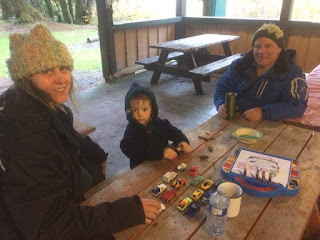It was a fun expedition, feeling like you really were getting off the beaten track. The drive in over the dirt logging road was a pothole fest with plenty of bumps and big trucks. It felt a bit like the road to Nomash River Cave. However the difference was that you could be in town in 20 minutes rather than an hour and a half.
Jo arranged for the camp ground to be opened for us as it was normally closed in winter. My fun experience was with the gate. When Heather and I arrived, it looked closed and locked. It took a bit of coordination over chat for me to realize that the lock was just partially on. It was kind of funny, and we did get in.
Most people arrived the Friday night. They had a great find in a covered event area complete with concrete fire pit. We had no idea such an area existed and would definitely use it again.
The problem usually was with the wind and rain. Portable event tents had been used before to keep the rain off, but they were difficult to secure against wind. This structure was large and sturdy, with 8 picnic tables inside and the large fire pit. With the fire going it was very comfortable. You could even drive up to it, gear up completely and then drive over to the beach. Pretty sweet!
The full roster was Jo, Julie, Jim, Tori, Jeff, Francoise, Bridgette, little Pierre, and Hunter (Tori's nephew). Heather and I were there for Saturday only. Jo and Julie got some great group pictures.
Julie showing off breakfast.
Tori, little Pierre, and Jim playing cars.
Bridgette, Jeff and Francoise.
Tori getting beaten at cards by Hunter and Julie.
Even the bathrooms (complete with showers) were heated. The staff went the extra mile to put in a little portable space heater. You could even rinse your gear with the taps and hoses.
On Saturday morning we did the first dives. Everyone had a great time socializing while leisurely gearing up.
There was some miscommunication on which camp site to meet at for the dive, and this was something to improve on next time. Part of one team went to the usual location of site 42, while the other teams went directly to the area near the rock wall. Oops!
Bridgette had a hole in her dry suit so had to abort her dive. This left the dive teams of Jim and Jo (doing a tech dive with scooters to check out how far the rock wall went), Jeff and Francoise doing photos, and myself and Heather doing the same.
As usual the surface layer was cold water runoff from the creek, but it was only 9 degrees! It did make for a very distinct and cool halocline as if you look carefully in this short video clip.
The visibility was good, but not as great as the West side of Vancouver island could be. I estimated it as easily 18 meters or 60 feet. Heather and I were up at 12 meters and could easily see Jim and Jo scootering below us, and they were at 30 meters at that point.
On our swim out, we almost missed the log tender wreck at 12 meters. I'm not sure how, since when I turned around it was right there. Alas no juvenile wolf eel was living in it this time. Heather got quite a few good pictures. Here was a very nice Leafy Hornmouth.
We happened on many pretty swimming scallops. One swam for it's life. I'd never seen one swim straight up so fast before.
We found the telephone booth and I tried to make a call. Surprisingly, I only heard bubbles.
There were many brown Rockfish and a few Black Rockfish too. Not something that we saw on the Vancouver side. Kelp Greenlings, large Ling Cod, Painted Greenlings, and sea stars rounded out the easiest to spot life.
There were several of these strange solitary tunicates, which turned out to be Glassy Sea Squirts. Pretty cool!
Heather got a neat picture of these Orange Ball Sponges, which looked like they just popped out of a volcano. I certainly didn't remember seeing them in other areas.
The best encounter was the Grunt Sculpin that Heather found. I had been looking at a sea star, and was quite surprised when she gestured very animatedly at it. Right there was a big Grunt Sculpin, sitting very still trying not to be noticed. It certainly fooled me!
Just after the Grunt Sculpin was a rock crack filled with a film of white substance. It wasn't stringy, but more like a layer of white mold or fungus. I emailed the Vancouver Aquarium about it, and they weren't quite sure, thinking it was some kind of decay. I wish I had gotten some video of it, but I had seen something like it before. I'd keep investigating.
In the shallows was a very pretty Fried Egg Jellyfish, just swimming along lazily.
Jim and Jo reported that there were three fishing nets at about 33 meters, which would make good clean up targets for a future dive. Francoise and Jeff said they saw nothing of particular note, but had a good dive.
Back at camp, Julie, Bridgett and Tori had little Pierre and Hunter well in hand, and the fire was blazing. It was a welcome opportunity for us divers to warm up! Jo had a suit leak so was very wet and cold. There was even time to put together a gingerbread house. Now that was camping in style!
Heather and I left the intrepid campers that afternoon, as we were staying in Parksville. I heard from Jo later that they weren't able to do any more diving due to weather. Still, the fire and camping and socializing sure was fun. And the dives we did get in were excellent. I couldn't wait for next year!







































































